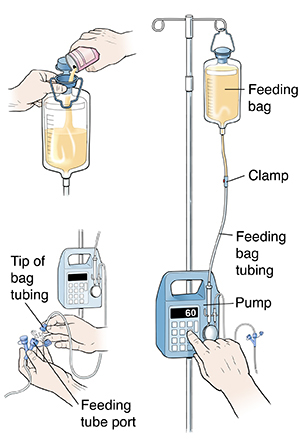Continuous Tube Feeding
Continuous Tube Feeding

There are different types of feeding bag tubing and feeding tubes. One has a connection that lets you plug or push the feeding bag tubing tip into the feeding tube port. A newer type has a twist-on safety connector. The twist-on feature means you must use a specific type of feeding bag tubing that twists onto your feeding tube port. Check with your care team to make sure you are following the steps for your specific type of feeding bag tubing and feeding tube.
Start the first daily feeding with a clean feeding bag. After the last feeding, run warm, soapy water through the bag and tubing. Rinse them well and hang to dry.
1. Filling the feeding bag
Turn the pump to STOP/OFF.
Close the clamp on the feeding bag tubing.
Pour the prescribed amount of liquid food into the feeding bag.
Hang the feeding bag on the pole above the pump. Make sure the bag tubing hangs straight.
Open the clamp slowly. Let a small amount of food run through the end of the tubing into a measuring cup or bowl. This clears air out of the tubing and helps prevent gas.
Close the clamp on the tubing.
2. Connecting the feeding bag
Put the feeding bag tubing through the front of the pump.
Connect the feeding bag tubing to the feeding tube port.
Plug-in port. If you have a feeding tube with a plug-in type port, push the tip of the feeding bag tubing into the feeding tube port.
Twist-on port. If you have a twist-on feeding port, screw the feeding bag tubing onto your feeding port.
Open the clamp on the feeding bag tubing.
3. Turning on the pump
Check that the settings on the pump are correct. (You may want to write the settings on a piece of paper. Attach the paper to the pump.)
Turn the pump to START/ON.
Checking residuals: You may be told to check the amount of feeding left in the stomach (residuals) at given times. If so, you’ll be told what to do for different amounts of residuals.
Updated:
January 26, 2018
Sources:
Continuous versus bolus infusion of enteral nutrition in intensive care unit. Abdelsalam Y. Anveshana Ayurveda Medical Journal. 2012;10(3):154-168., Nutrition Support in Critically Ill Patients: Enteral Nutrition. UpToDate, Operating room hazards and approaches to improve patient safety, Up to Date, The American Society for Parenteral and Enteral Nutrition (A.S.P.E.N.) Enteral Nutrition Practice Recommendations. Bankhead R. Journal of Parenteral and Enteral Nutrition. 2009;33(2):s122-67.
Reviewed By:
Freeborn, Donna, PhD, CNM, FNP,Image reviewed by StayWell medical illustration team.,Lehrer, Jenifer, MD,Watson, L. Renee, RN, MSN